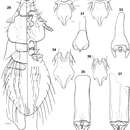Description
provided by Zookeys
Head, thorax and abdomen as in Fig. 29. Head sub-conical, marginal carina entire laterally, with well developed anterior dorsal and ventral head plates. Anterior setae 3 (as3) rigid, 0.04 in length. Dorsal head plate with convex lateral margins and almost straight posterior margin, bearing rigid anterior dorsal head setae (ads), as the adults. Anterior ventral plate cordiform. Marginal temporal setae 3 (m.t.s.3) very long, other temporal setae short to minute. Each of the pair of posterior setae on pronotum located half way between the middle of the segment and its lateroposterior angle. Only four long pterothoracic setae, as in the second nymphal stage of most species of Philopteridae (Mey 1994). Abdomen mostly membranous, except for the tergo-pleural plate of second segment (first visible), and the pleural plates of segments III–V. Segments VI and VII with small patches of light sclerotization. Abdominal chaetotaxy as in Fig. 29, with two long dorsal setae plus the postspiracular seta on each side of segments III–VIII. Sternites II–III with one spine-like setae among three long setae on each side, IV–V with a pair of long setae each side, and VI–VIII with only one long setae on each side. One long pleural seta on III–VIII. Measurements (n=1): HL 0.37, ANW 0.11, POL 0.14, POW 0.27, ADPL 0.12, ADPW 0.14, TRL 0.08, TRW 0.04, TW 0.36, PW 0.21, PTW 0.29, AW 0.43, TL 1.06.
- license
- cc-by-3.0
- copyright
- Michel P. Valim, Ricardo L. Palma
- bibliographic citation
- Valim M, Palma R (2013) Three new species of the genus Philopteroides Mey, 2004 (Phthiraptera, Ischnocera, Philopteridae) from New Zealand ZooKeys 297: 71–89
- author
- Michel P. Valim
- author
- Ricardo L. Palma
Distribution
provided by Zookeys
Uganda.
This species was recently described in detail and, therefore, it is not necessary to redescribed it again. We only include habitus images of the holotype male and one paratype female (Figs 1–2), not figured in the original description by Mey (2004). We also include illustrations to support our change of the original generic combination of this species, and have re-drawn only those characters (Figs 9, 13–16, 30) useful to distinguish it from the second species described below. In addition, the second nymphal stage is described from a single specimen (Fig. 29) mounted together with the female paratype, and a re-interpretation of the male genitalia is presented in Fig. 31.
All species of the genus Tyranniphilopterus Mey, 2004 have the following characters, which are lacking in “Tyranniphilopterus” beckeri: (1) hyaline margin arises at a level below the as3; (2) conspicuous antero-lateral projections on anterior dorsal head plate; (3) prothoracic dorsal setae located on the posterior-lateral angles of the segment, not on its posterior margin.; (4) pleuro-tergal plates II–III with well developed postero-lateral projections. Instead, “Tyranniphilopterus” beckeri has the features which define Philopteroides. These morphological features justify placing it in the latter genus, as Philopteroides beckeri (Mey, 2004) new combination.
Furthermore, the hosts of all species of Tyranniphilopterus – except for “Tyranniphilopterus” beckeri – belong to the passerine suborders Tyranni and Passeri, and are confined to the Americas, while the hosts of all species of Philopteroides belong to the passerine suborders Passeri and Acanthisitti distributed in Africa, Asia and Oceania. Hence, the geographical distribution of its host is further evidence that placing “Tyranniphilopterus” beckeri in the genus Philopteroides is correct.
- license
- cc-by-3.0
- copyright
- Michel P. Valim, Ricardo L. Palma
- bibliographic citation
- Valim M, Palma R (2013) Three new species of the genus Philopteroides Mey, 2004 (Phthiraptera, Ischnocera, Philopteridae) from New Zealand ZooKeys 297: 71–89
- author
- Michel P. Valim
- author
- Ricardo L. Palma

